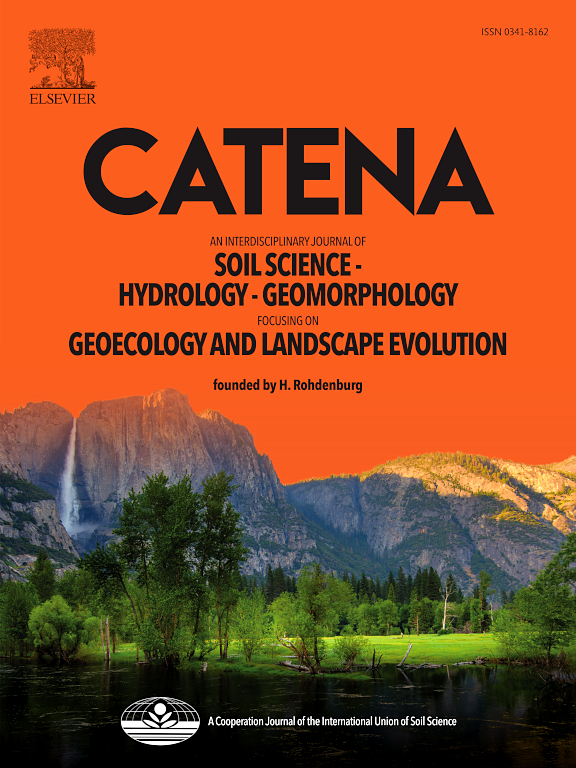IF 5.4
1区 农林科学
Q1 GEOSCIENCES, MULTIDISCIPLINARY
引用次数: 0
摘要
兴凯湖位于中俄边境,是东北亚最大的浅水湖泊。目前基于该湖沉积物的研究大多集中于过去 103-106 年的气候演变,而对高分辨率的近期环境变化研究有限。本研究从湖泊北部地区(中国部分)采集了三个短沉积物岩芯,并采用 210Pb/137Cs 放射性方法测定了其年代。通过分析硅藻群落和沉积物理化指标,如总有机碳(TOC)、铅、铁/锰、频率相关磁感应强度(χfd)和沉积物堆积率(SAR)的变化,重建兴凯湖北部近 200 年的环境变化。结果表明,20 世纪 90 年代以前,硅藻群以颗粒硅藻(Aulacoseira granulata)为主。自 20 世纪 90 年代末以来,出现了富营养化现象,硅藻的优势种转变为 Cyclostephanos dubius。耕地面积、χfd、沉积物 TP 和年平均风速是解释硅藻群变化的四个最重要的环境变量,这表明农业干扰是环境退化的主要驱动因素。此外,研究还揭示了湖泊沉积环境的空间差异。20 世纪 90 年代末之前硅藻群的相对稳定性表明,兴凯湖在 21 世纪初之前经历了较低程度的富营养化,因此其生态系统的恢复能力可能高于一般的小型湖泊。在硅藻发生显著变化之前测得的平均上浮 TP 浓度为 35 μg/L,可作为该湖泊富营养化管理的参考营养条件。该研究为中国和俄罗斯的兴凯湖治理提供了科学依据,同时也丰富了世界大型湖泊环境变化的研究案例。本文章由计算机程序翻译,如有差异,请以英文原文为准。
Multi-proxy paleolimnological evidence for recent environmental degradation of Xingkai Lake, the largest shallow lake in Northeast Asia
Located at the border between China and Russia, Xingkai Lake is the largest shallow lake in Northeast Asia. Current studies based on the lake’s sediments mostly focus on the climatic evolution over the past 103-106 years, with limited research on high-resolution recent environmental changes. In this study, three short sediment cores were collected from the northern area (in the Chinese part) of the lake and dated using 210Pb/137Cs radiometric methods. The changes in diatom communities and sediment physicochemical indicators, such as total organic carbon (TOC), Pb, Fe/Mn, frequency-dependent magnetic susceptibility (χfd) and sediment accumulation rate (SAR), were analyzed to reconstruct environmental change in the northern part of Xingkai Lake over the last 200 years. Results show that the diatom assemblages were dominated by Aulacoseira granulata prior to the 1990s. Since the late 1990s, eutrophication has emerged, with a shift to Cyclostephanos dubius as the dominant diatom species. Cultivated land area, χfd, sediment TP and annual mean wind speed were the four most important environmental variables explaining the shifts in the diatom assemblages, suggesting that agricultural disturbance is the main driver of environmental degradation. Additionally, the study reveals some spatial difference in depositional environments in the lake. The relative stability of the diatom assemblages before the late 1990s suggests that Xingkai Lake experienced low levels of eutrophication prior to the start of the twenty-first century and may thus have a higher ecosystem resilience than is typically seen in smaller lakes. The mean epilimnetic TP concentration of 35 μg/L measured before the significant diatom change can be used as a reference nutrient condition for eutrophication management of this lake. The study provides a scientific basis for the management of Xingkai Lake in China and Russia, and also enriches the research cases of environmental change in the world’s large lakes.
求助全文
通过发布文献求助,成功后即可免费获取论文全文。
去求助
来源期刊

Catena
环境科学-地球科学综合
CiteScore
10.50
自引率
9.70%
发文量
816
审稿时长
54 days
期刊介绍:
Catena publishes papers describing original field and laboratory investigations and reviews on geoecology and landscape evolution with emphasis on interdisciplinary aspects of soil science, hydrology and geomorphology. It aims to disseminate new knowledge and foster better understanding of the physical environment, of evolutionary sequences that have resulted in past and current landscapes, and of the natural processes that are likely to determine the fate of our terrestrial environment.
Papers within any one of the above topics are welcome provided they are of sufficiently wide interest and relevance.
 求助内容:
求助内容: 应助结果提醒方式:
应助结果提醒方式:


